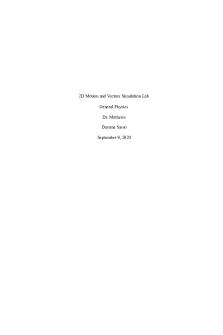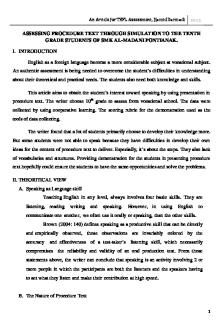Vectors Addition by Graphical and Analytical Methods Using Phet Simulation PDF

| Title | Vectors Addition by Graphical and Analytical Methods Using Phet Simulation |
|---|---|
| Author | Matthew Mondragon |
| Course | Physics I |
| Institution | California State University Monterey Bay |
| Pages | 5 |
| File Size | 456.1 KB |
| File Type | |
| Total Downloads | 62 |
| Total Views | 160 |
Summary
In this physics lab you will be adding vectors by graphical and analytical methods . ...
Description
Vectors Addition by Graphical and Analytical Methods Using Phet Simulation Name : Matthew Mondragon
Date: 09-03-20
https://phet.colorado.edu/sims/html/vector-addition/latest/v https://phet.colorado.edu/sims/html/vector-addition/latest/vector-addition_en.html ector-addition_en.html
Objectives: In this experiment you should learn the definition of a vector, and how to represent it in space. Also, you should learn how to apply the rules for vector addition both graphically and analytically. Theory The resultant vector (VR) of two Vectors as an example v1 & v2 can be found by two methods analytical or graphical method. In the analytical method each vector (Vector) such as (v) which makes an angle (θ) with horizontal x- axis is first resolved into two components. Those components are horizontal or x- component (vx) and vertical or y- component (vy ). Those components are given by: vx = v cos q
vy
vy = v sin q
v
q vx Consider the case of three vectors (Vectors) v1, v2, v3 FRx = v1x + v2x + v3x & vRy = v1y + v2y + v3y The magnitude of the resultant vector (vR) is found to be the following because the components Rx and Ry are at right angles:
( R x ) 2 + ( R y )2
R = and the angle ( q ) that the resultant makes with x- axis is given by :
q = tan
-1
(
Ry Rx
)
In the graphical addition process. The resultant vector is the vector drawn from the tail of the first vector to the head of the last vector The polygon method is illustrated for the case of three vectors as follows:
C
b
R
B
C b
a
A q
a
B
A To verify the objectives experimentaly we will use phe oftware and we will act on an object by two vectors and then three vectors, then we will find d by finding practicaly the eequilibrit vector (vE). So, the vE is the equilibrant vector that must be applied in order to keep an object in equilibrium. The magnitude and direction of this vE can be found by trial and error experimentally. The resultant vector VR can be found from knowledge that vR and vE have the same magnitude but opposite directions. 1
Part one: Adding two vectors. Use v1 as first vecrors and v2 as second vector on phet simulation.
Graphical Methot a. Fix the first vector (v1) on about 20o angle and fix it is magnitude about 10m/s. b. The second vector ( v2) starts at the head of first vector, fix it about 90o angle and control it is value to be almost 8m/s. c. Find the resultant vector VR ( magnitude and direction ) d. (attach a screen shot of the graphical method)
qR=
VR= 1
(Graphically)
Analytical method: 1) Use Phet simulation for each vector to display the vector’s components and then fill v1x, v2x, |FR|, and the angle θ in table 1. Table 1 Vector v1 v2 VR
q = tan
Vector (m/s) 10 8
-1
(
Ry Rx
)
Direction 20o 90o
x-component 9.4 0.0 9.4
Ry=11.4, Rx=9.4 2
y-component 3.4 8.0 11.4
R =
2
2
( Rx ) + ( Ry )
(9.4) ^2+(11.4)^2=14.78 qR =
VR = 1
(analytically)
A. Calculate the percentage difference magnitudes of two resultant vectors from two different methods. (Result 1- Result 2/Average Result) x100 = Average = 14.8+14.78/2=14.79 (14.8m/s-14.78m/s/14.79m/s) x 100 =
B. Calculate the percentage difference in angles of resultant vectors from two different methods. (Result 1- Result 2/Average Result) x100 = Average = 50. +50.4 /2= 50. (50. -50.4 /50. ) x 100 = 0
Part two: Adding three vectors. Graphical Method for three vectors a. Fix the first vector (v1) on about 30o angle and fix it is magnitude about 6m/s. b. The second vector ( v2) starts at the head of first vector, fix it about 100o angle and value to be almost 8m/s. c. The third vector ( v3) starts at the head of second vector, fix it about 145o angle and value to be almost 11m/s. d. Find the resultant vector VR ( magnitude and direction )
3
qR = 1
VR =
(Graphically)
Analytical method for three vectors: 1) Use Phet simulation for each vector to display the vector’s components and then fill v1x, v2x, v3x, |VR|, and the angle θ in table 2. Table 2 Vector v1 v2 v3 VR
Vector (m/s) 6 8 11
q = tan R = VR =
-1
(
Ry Rx
)
Direction 30o 100o 145o
x-component 5.0 -1.0 -9.0 -5.0
y-component 3.0 8.0 6.0 17.0
Ry=17.0, Rx=-5.0
( R x ) 2 + ( R y )2
(17.0) ^2+(-5.0) ^2=17.2m/s qR =
(analytically)
A. Calculate the percentage difference between two resultant vectors from two different methods.
(Result 1- Result 2/Average Result) x100 = Average = 17.7m/s+17.2m/s/2=17.45m/s (17.7m/s-17.2m/s/17.45m/s) x 100 =
B. Calculate the percentage difference between two angles from two different methods. 4
(Result 1- Result 2/Average Result) x100 = Average = 106.4+73.6/2= (106.4-73.6/90) x 100=
Questions: 1) What is the difference between vector and scalar quantity? Vector has a direction and a magnitude; scalar quality only has magnitudes.
2) Classify each of the following physical quantities as vectors or scalars: a) Volume: Scalar b) Vector: Vector c) density: Scalar d) velocity: Vector
e) distance: Scalar
g) mass: Scalar
h) speed: Scalar
f) acceleration: Vector i) weight: Scalar
3) What are the conditions for the two vectors to be equal? In order for two vectors to be equal they need to have equal magnitude and same direction.
5...
Similar Free PDFs

Vectors addition and Subtraction
- 3 Pages

Lab2S Moving Man Phet Simulation
- 3 Pages

Analytical Methods for Risk Management
- 284 Pages

Tutorial Simulation Using Abaqus CAE
- 15 Pages
Popular Institutions
- Tinajero National High School - Annex
- Politeknik Caltex Riau
- Yokohama City University
- SGT University
- University of Al-Qadisiyah
- Divine Word College of Vigan
- Techniek College Rotterdam
- Universidade de Santiago
- Universiti Teknologi MARA Cawangan Johor Kampus Pasir Gudang
- Poltekkes Kemenkes Yogyakarta
- Baguio City National High School
- Colegio san marcos
- preparatoria uno
- Centro de Bachillerato Tecnológico Industrial y de Servicios No. 107
- Dalian Maritime University
- Quang Trung Secondary School
- Colegio Tecnológico en Informática
- Corporación Regional de Educación Superior
- Grupo CEDVA
- Dar Al Uloom University
- Centro de Estudios Preuniversitarios de la Universidad Nacional de Ingeniería
- 上智大学
- Aakash International School, Nuna Majara
- San Felipe Neri Catholic School
- Kang Chiao International School - New Taipei City
- Misamis Occidental National High School
- Institución Educativa Escuela Normal Juan Ladrilleros
- Kolehiyo ng Pantukan
- Batanes State College
- Instituto Continental
- Sekolah Menengah Kejuruan Kesehatan Kaltara (Tarakan)
- Colegio de La Inmaculada Concepcion - Cebu











